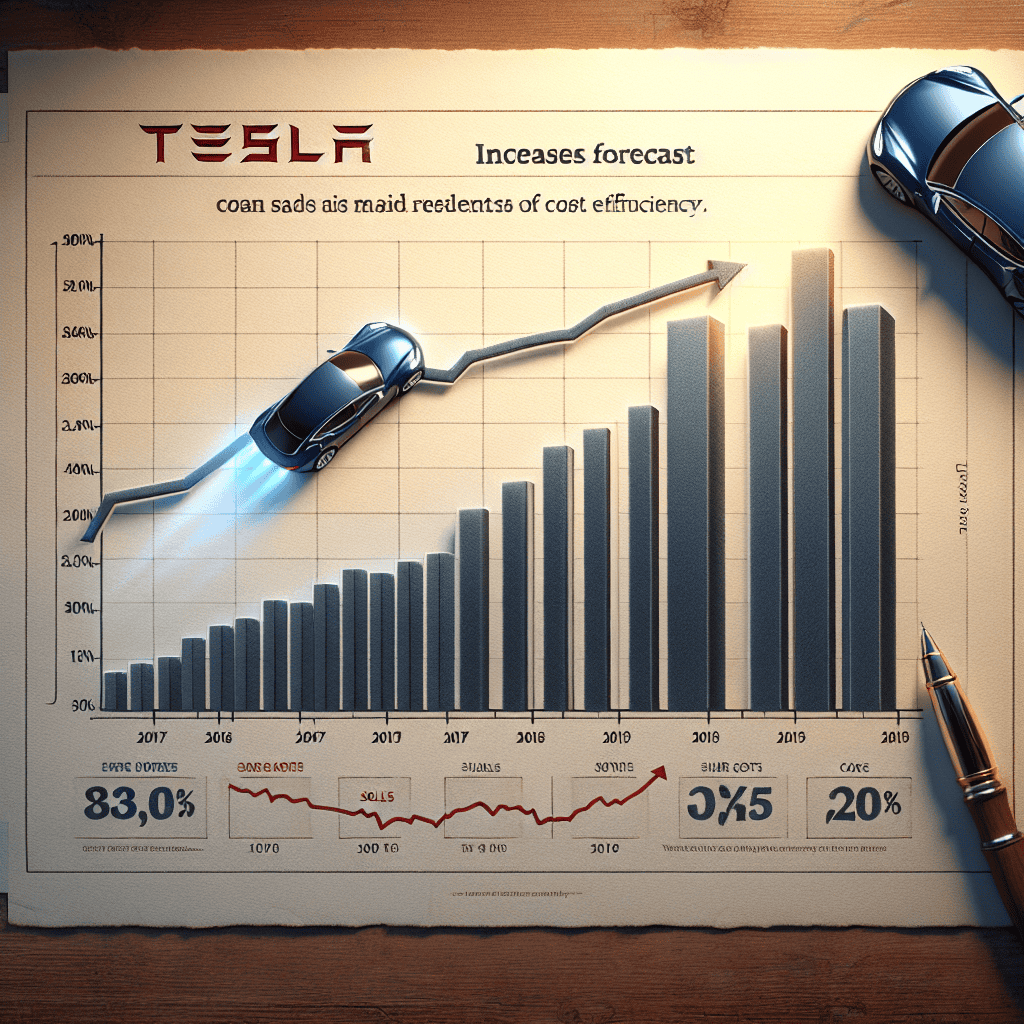“Driving Profits: Tesla’s Strategic Sales Forecast and Cost Efficiency Ignite Share Growth”
Introduction
Tesla’s sales forecast and cost efficiency have become pivotal factors in boosting the company’s shares, reflecting its strategic positioning in the competitive electric vehicle market. As Tesla continues to expand its global footprint, the company’s ability to project robust sales growth is underpinned by its innovative product lineup, increasing production capacity, and entry into new markets. Simultaneously, Tesla’s focus on cost efficiency, driven by advancements in manufacturing processes and supply chain optimization, has enhanced its profitability margins. These elements combined have instilled investor confidence, leading to a positive impact on Tesla’s stock performance. The company’s commitment to scaling operations while maintaining financial discipline is seen as a key driver of its long-term success and market leadership in the sustainable transportation sector.
Analyzing Tesla’s Sales Forecast: Key Drivers and Market Trends
Tesla’s recent sales forecast has captured the attention of investors and market analysts alike, as the company continues to demonstrate its prowess in the electric vehicle (EV) sector. The forecast, which projects significant growth in sales, is underpinned by several key drivers and market trends that are shaping the future of the automotive industry. As Tesla navigates this dynamic landscape, its focus on cost efficiency has further bolstered investor confidence, leading to a notable increase in its share value.
One of the primary drivers of Tesla’s optimistic sales forecast is the growing global demand for electric vehicles. As environmental concerns intensify and governments worldwide implement stricter emissions regulations, consumers are increasingly turning to EVs as a sustainable alternative to traditional internal combustion engine vehicles. Tesla, with its strong brand recognition and reputation for innovation, is well-positioned to capitalize on this shift in consumer preferences. Moreover, the company’s commitment to expanding its production capacity, particularly with the opening of new Gigafactories in strategic locations, is expected to enhance its ability to meet the rising demand.
In addition to the favorable market conditions, Tesla’s continuous advancements in technology play a crucial role in driving its sales forecast. The company’s investment in research and development has led to significant improvements in battery technology, which is a critical component of electric vehicles. By increasing the energy density and reducing the cost of its batteries, Tesla is able to offer vehicles with longer ranges and more competitive pricing. This technological edge not only strengthens Tesla’s position in the market but also attracts a broader customer base, further fueling sales growth.
Furthermore, Tesla’s strategic focus on cost efficiency has been instrumental in boosting its share value. The company has implemented various measures to streamline its operations and reduce production costs, thereby improving its profit margins. For instance, Tesla’s vertical integration strategy, which involves controlling the supply chain from raw materials to finished products, allows for greater control over costs and quality. Additionally, the use of advanced manufacturing techniques, such as automation and robotics, has enhanced production efficiency and reduced labor costs. These efforts to optimize cost structures have not only improved Tesla’s financial performance but also instilled confidence among investors regarding the company’s long-term profitability.
As Tesla continues to expand its global footprint, it is also benefiting from strategic partnerships and collaborations. By forging alliances with key players in the automotive and technology sectors, Tesla is able to leverage synergies and accelerate its growth trajectory. These partnerships facilitate access to new markets, enhance product offerings, and drive innovation, all of which contribute to the company’s robust sales forecast.
In conclusion, Tesla’s sales forecast is driven by a confluence of factors, including rising demand for electric vehicles, technological advancements, and strategic cost management. The company’s ability to adapt to evolving market trends and capitalize on emerging opportunities has positioned it as a leader in the EV industry. As a result, Tesla’s shares have experienced a significant boost, reflecting investor confidence in the company’s growth prospects. Moving forward, Tesla’s continued focus on innovation and efficiency will be crucial in sustaining its competitive advantage and achieving its ambitious sales targets.
How Cost Efficiency Strategies Are Boosting Tesla’s Profit Margins
Tesla’s recent surge in share prices can be attributed to a combination of optimistic sales forecasts and strategic cost efficiency measures that have significantly bolstered the company’s profit margins. As the electric vehicle (EV) market continues to expand, Tesla remains at the forefront, leveraging its innovative prowess and operational strategies to maintain a competitive edge. The company’s ability to forecast robust sales growth is underpinned by its expanding global footprint and the increasing consumer demand for sustainable transportation solutions. However, it is not merely the sales projections that have captured the attention of investors; it is Tesla’s adeptness at enhancing cost efficiency that has truly fortified its financial standing.
To begin with, Tesla’s focus on cost efficiency is evident in its manufacturing processes. The company has consistently invested in advanced technologies and automation to streamline production. By doing so, Tesla has managed to reduce the cost per vehicle, thereby improving its overall profit margins. The Gigafactories, strategically located across different continents, play a pivotal role in this regard. These facilities are designed to optimize production capacity while minimizing waste and energy consumption. Consequently, Tesla can produce vehicles at a lower cost, which translates into higher profitability.
Moreover, Tesla’s vertical integration strategy further contributes to its cost efficiency. By controlling various aspects of the supply chain, from battery production to software development, Tesla reduces its reliance on external suppliers. This not only mitigates risks associated with supply chain disruptions but also allows the company to maintain tighter control over costs. The in-house production of batteries, in particular, is a significant advantage, as it enables Tesla to manage one of the most expensive components of an electric vehicle more effectively.
In addition to manufacturing efficiencies, Tesla’s approach to research and development (R&D) is another area where cost efficiency is evident. The company allocates substantial resources to R&D, focusing on innovations that enhance vehicle performance and reduce production costs. For instance, Tesla’s advancements in battery technology have led to longer-lasting and more efficient batteries, which are crucial for maintaining a competitive edge in the EV market. By prioritizing R&D, Tesla not only drives innovation but also ensures that it remains cost-competitive.
Furthermore, Tesla’s strategic pricing decisions have also played a role in boosting profit margins. The company has demonstrated a keen understanding of market dynamics, adjusting prices in response to demand fluctuations and competitive pressures. This flexibility allows Tesla to maximize revenue without compromising on profitability. Additionally, the introduction of new models and features at various price points caters to a broader customer base, thereby driving sales growth.
As Tesla continues to implement these cost efficiency strategies, the impact on its financial performance is evident. The company’s ability to maintain healthy profit margins while expanding its market presence is a testament to its strategic acumen. Investors have taken note of these developments, as reflected in the rising share prices. The confidence in Tesla’s future prospects is not solely based on its sales forecasts but also on its proven track record of operational efficiency.
In conclusion, Tesla’s success in boosting profit margins through cost efficiency strategies is a key factor driving its share price appreciation. By optimizing manufacturing processes, embracing vertical integration, prioritizing R&D, and making strategic pricing decisions, Tesla has positioned itself as a leader in the EV market. As the company continues to innovate and expand, its commitment to cost efficiency will undoubtedly play a crucial role in sustaining its competitive advantage and financial success.
The Impact of Global Demand on Tesla’s Sales Projections
Tesla’s recent sales forecast has captured the attention of investors and industry analysts alike, as the company continues to navigate the complexities of global demand. The electric vehicle (EV) giant has consistently been at the forefront of innovation, and its ability to adapt to changing market conditions has been a key factor in its sustained growth. As Tesla projects increased sales figures, the impact of global demand on these projections cannot be overstated. This interplay between demand and sales forecasts is crucial for understanding the company’s current trajectory and future prospects.
To begin with, Tesla’s sales projections are significantly influenced by the growing global demand for electric vehicles. As environmental concerns become more pressing, consumers and governments worldwide are increasingly prioritizing sustainable transportation solutions. This shift in consumer preferences has led to a surge in demand for EVs, with Tesla being one of the primary beneficiaries. The company’s ability to capitalize on this trend is evident in its ambitious sales forecasts, which reflect a strong confidence in its capacity to meet the rising demand.
Moreover, Tesla’s strategic expansion into international markets has further bolstered its sales projections. By establishing a presence in key regions such as Europe and Asia, Tesla has tapped into new customer bases, thereby diversifying its revenue streams. This global expansion not only enhances the company’s market reach but also mitigates risks associated with over-reliance on any single market. Consequently, Tesla’s sales forecasts are buoyed by its robust international strategy, which positions the company to leverage global demand effectively.
In addition to expanding its market presence, Tesla has also focused on improving cost efficiency, a move that has positively impacted its share prices. By optimizing production processes and supply chain management, Tesla has managed to reduce operational costs, thereby increasing its profit margins. This emphasis on cost efficiency is particularly important in the context of fluctuating global demand, as it allows Tesla to maintain competitive pricing without compromising on quality. As a result, investors have responded favorably to Tesla’s cost management strategies, leading to a boost in the company’s share prices.
Furthermore, Tesla’s commitment to innovation plays a pivotal role in shaping its sales projections. The company’s continuous investment in research and development has resulted in cutting-edge technologies that enhance the performance and appeal of its vehicles. From advancements in battery technology to the development of autonomous driving features, Tesla’s innovative approach ensures that its products remain at the forefront of the EV market. This commitment to innovation not only attracts new customers but also fosters brand loyalty among existing ones, thereby sustaining demand and supporting optimistic sales forecasts.
In conclusion, the impact of global demand on Tesla’s sales projections is multifaceted, encompassing factors such as consumer preferences, international expansion, cost efficiency, and innovation. As the world increasingly embraces sustainable transportation, Tesla’s ability to align its strategies with this global trend is crucial for its continued success. By effectively responding to the dynamics of global demand, Tesla not only strengthens its market position but also enhances shareholder value, as evidenced by the recent boost in its share prices. As the company moves forward, maintaining this delicate balance between demand and operational efficiency will be key to sustaining its growth trajectory in the ever-evolving automotive landscape.
Innovations in Production: Tesla’s Path to Cost Efficiency

Tesla’s recent surge in share prices can be attributed to its strategic focus on sales forecasts and cost efficiency, which have become pivotal in the company’s operational blueprint. As the electric vehicle (EV) market continues to expand, Tesla’s innovative approach to production has positioned it as a leader in the industry. The company’s commitment to reducing production costs while maintaining high-quality standards has not only enhanced its competitive edge but also bolstered investor confidence.
One of the key elements in Tesla’s strategy is its emphasis on vertical integration. By controlling a significant portion of its supply chain, Tesla has managed to reduce dependency on external suppliers, thereby minimizing costs and potential disruptions. This approach allows the company to streamline its production processes, ensuring that each component of its vehicles meets the stringent quality standards that Tesla is known for. Moreover, vertical integration facilitates rapid innovation, enabling Tesla to swiftly implement new technologies and production techniques.
In addition to vertical integration, Tesla has invested heavily in automation and advanced manufacturing technologies. The company’s Gigafactories, strategically located around the world, are equipped with state-of-the-art machinery that enhances production efficiency. Automation not only reduces labor costs but also increases the precision and consistency of the manufacturing process. This technological prowess is complemented by Tesla’s commitment to sustainable practices, as the company continues to explore renewable energy sources to power its facilities, further reducing operational costs.
Furthermore, Tesla’s focus on cost efficiency extends to its research and development (R&D) efforts. By investing in cutting-edge technologies and materials, Tesla aims to reduce the cost of its battery packs, which are among the most expensive components of electric vehicles. The development of more efficient battery technologies not only lowers production costs but also enhances the performance and range of Tesla’s vehicles, making them more appealing to consumers. This dual benefit of cost reduction and product enhancement is a testament to Tesla’s innovative approach to R&D.
Tesla’s sales forecast also plays a crucial role in its cost efficiency strategy. By accurately predicting market demand, Tesla can optimize its production schedules and inventory management, reducing the risk of overproduction or stock shortages. This foresight is particularly important in the rapidly evolving EV market, where consumer preferences and regulatory landscapes can shift quickly. Tesla’s ability to adapt to these changes and align its production with market demand is a key factor in its financial success.
Moreover, Tesla’s direct-to-consumer sales model further enhances its cost efficiency. By eliminating traditional dealership networks, Tesla reduces distribution costs and maintains greater control over the customer experience. This model not only contributes to cost savings but also strengthens brand loyalty, as consumers appreciate the seamless and personalized purchasing process.
In conclusion, Tesla’s focus on cost efficiency through innovations in production has significantly contributed to its recent share price increase. The company’s strategic initiatives, including vertical integration, automation, advanced R&D, and an accurate sales forecast, have positioned it as a leader in the EV market. As Tesla continues to refine its production processes and expand its global footprint, its commitment to cost efficiency will likely remain a cornerstone of its business strategy, driving further growth and success in the years to come.
Tesla’s Competitive Edge: Balancing Sales Growth and Cost Management
Tesla’s recent performance in the automotive market has been a subject of considerable interest, particularly as the company continues to balance its ambitious sales growth targets with a keen focus on cost management. This dual strategy has not only bolstered investor confidence but also positioned Tesla as a formidable competitor in the electric vehicle (EV) industry. As the company navigates the complexities of scaling production while maintaining profitability, its approach offers valuable insights into the dynamics of modern automotive manufacturing.
To begin with, Tesla’s sales forecast has been a critical driver of its recent stock performance. The company has consistently set ambitious delivery targets, aiming to increase its market share in the rapidly expanding EV sector. This growth trajectory is supported by Tesla’s continuous innovation in vehicle design and technology, which has helped maintain strong consumer demand. The introduction of new models and the expansion of production facilities, such as the Gigafactories in Texas and Berlin, are pivotal to meeting these targets. These strategic moves not only enhance production capacity but also reduce logistical challenges, thereby facilitating smoother operations.
In tandem with its sales ambitions, Tesla has placed a significant emphasis on cost efficiency. The company’s ability to streamline production processes and reduce manufacturing costs has been instrumental in maintaining competitive pricing for its vehicles. By leveraging economies of scale and investing in advanced manufacturing technologies, Tesla has managed to lower the cost per unit, which in turn supports its pricing strategy. This focus on cost management is crucial, especially in an industry where price competitiveness can significantly influence consumer choice.
Moreover, Tesla’s vertical integration strategy further underscores its commitment to cost efficiency. By controlling various aspects of the supply chain, from battery production to software development, Tesla minimizes dependency on external suppliers and mitigates risks associated with supply chain disruptions. This approach not only ensures a steady supply of critical components but also allows for greater flexibility in adapting to market changes. Consequently, Tesla can respond more swiftly to shifts in consumer demand and adjust its production strategies accordingly.
The interplay between sales growth and cost management has had a positive impact on Tesla’s financial performance, which is reflected in its stock market valuation. Investors have responded favorably to the company’s ability to deliver on its promises while maintaining a healthy balance sheet. The confidence in Tesla’s strategic direction is further reinforced by its robust financial metrics, including strong revenue growth and improving profit margins. These factors contribute to a positive outlook for the company’s future, as it continues to expand its footprint in the global automotive market.
In conclusion, Tesla’s approach to balancing sales growth with cost efficiency has proven to be a successful formula in enhancing its competitive edge. By setting ambitious sales targets and simultaneously focusing on reducing production costs, Tesla has managed to capture the attention of both consumers and investors alike. As the company continues to innovate and expand its operations, its strategic focus on these key areas will likely remain a cornerstone of its business model. This dual emphasis not only supports Tesla’s current market position but also lays a strong foundation for sustained growth in the years to come.
The Role of Renewable Energy in Tesla’s Sales and Cost Strategy
Tesla’s recent sales forecast and cost efficiency strategies have significantly boosted its shares, underscoring the pivotal role of renewable energy in the company’s overall strategy. As the global demand for sustainable energy solutions continues to rise, Tesla has positioned itself at the forefront of this transition, leveraging its innovative technologies and strategic foresight. The company’s commitment to renewable energy is not only a cornerstone of its product offerings but also a critical component of its operational efficiencies and market expansion plans.
To begin with, Tesla’s focus on renewable energy is evident in its diverse product lineup, which includes electric vehicles (EVs), solar energy products, and energy storage solutions. These offerings are designed to reduce reliance on fossil fuels and promote a more sustainable future. The company’s electric vehicles, for instance, have gained widespread popularity due to their performance, range, and environmental benefits. This popularity has translated into robust sales figures, which have been further bolstered by government incentives and increasing consumer awareness of climate change.
Moreover, Tesla’s solar energy products, such as solar panels and the Solar Roof, complement its EV lineup by providing customers with the means to generate clean energy at home. This integration of solar energy solutions with electric vehicles not only enhances the value proposition for consumers but also aligns with Tesla’s mission to accelerate the world’s transition to sustainable energy. By offering a comprehensive suite of renewable energy products, Tesla is able to capture a larger share of the market and drive sales growth.
In addition to its product strategy, Tesla’s emphasis on cost efficiency has played a crucial role in boosting its shares. The company has made significant strides in reducing production costs through innovations in manufacturing processes and supply chain management. For example, Tesla’s Gigafactories, strategically located around the world, are designed to produce batteries and vehicles at scale, thereby lowering per-unit costs. These cost efficiencies enable Tesla to offer competitive pricing, which is essential in attracting a broader customer base and maintaining its market leadership.
Furthermore, Tesla’s investment in research and development has led to advancements in battery technology, which are critical to both its EV and energy storage businesses. By improving battery performance and reducing costs, Tesla is able to enhance the appeal of its products while simultaneously increasing its profit margins. This focus on innovation and efficiency not only strengthens Tesla’s competitive position but also reassures investors of the company’s long-term growth potential.
As Tesla continues to expand its global footprint, the role of renewable energy in its sales and cost strategy becomes increasingly important. The company’s entry into new markets, particularly in regions with strong demand for sustainable energy solutions, is facilitated by its renewable energy offerings. This expansion is supported by strategic partnerships and collaborations that enhance Tesla’s ability to deliver its products and services efficiently.
In conclusion, Tesla’s sales forecast and cost efficiency strategies are intricately linked to its commitment to renewable energy. By integrating sustainable energy solutions into its product lineup and operations, Tesla is able to drive sales growth, reduce costs, and enhance shareholder value. As the world moves towards a more sustainable future, Tesla’s leadership in renewable energy positions it well to capitalize on emerging opportunities and continue its trajectory of success.
Future Outlook: Tesla’s Sales Forecast and Cost Efficiency in 2024 and Beyond
Tesla, the electric vehicle (EV) giant, has consistently been at the forefront of innovation in the automotive industry. As we look towards 2024 and beyond, the company’s sales forecast and cost efficiency strategies are pivotal factors that are expected to significantly influence its market performance and, consequently, its share value. The anticipation surrounding Tesla’s future sales is largely driven by its ambitious production targets and the expansion of its global footprint. With the increasing demand for sustainable transportation solutions, Tesla is poised to capitalize on this trend by ramping up production across its Gigafactories worldwide. The company’s strategic investments in new facilities, such as those in Berlin and Texas, are set to enhance its production capacity, enabling it to meet the growing consumer demand for electric vehicles. This expansion is not only expected to boost sales but also to solidify Tesla’s position as a leader in the EV market.
Moreover, Tesla’s focus on cost efficiency is another critical element that is likely to bolster its financial performance. The company has been actively working on reducing production costs through various means, including the optimization of its supply chain and the implementation of advanced manufacturing technologies. By streamlining its operations, Tesla aims to achieve economies of scale, which will allow it to offer its vehicles at more competitive prices. This cost reduction strategy is anticipated to widen Tesla’s profit margins, thereby enhancing its overall financial health and attractiveness to investors.
In addition to production and cost strategies, Tesla’s innovation in battery technology is expected to play a significant role in its future success. The development of more efficient and cost-effective batteries is crucial for the widespread adoption of electric vehicles. Tesla’s advancements in this area, particularly with its 4680 battery cells, promise to deliver longer range and faster charging times, which are key factors for consumers considering the switch from traditional internal combustion engine vehicles to electric ones. As these technological improvements come to fruition, they are likely to drive further consumer interest and increase sales.
Furthermore, Tesla’s commitment to sustainability and renewable energy solutions aligns with the global shift towards greener practices. This alignment not only enhances Tesla’s brand image but also positions it favorably in markets where environmental regulations are becoming increasingly stringent. As governments worldwide implement policies to reduce carbon emissions, Tesla’s electric vehicles are well-positioned to benefit from incentives and subsidies aimed at promoting clean energy transportation.
While the outlook for Tesla appears promising, it is important to acknowledge potential challenges that could impact its trajectory. The competitive landscape in the EV market is intensifying, with traditional automakers and new entrants alike vying for market share. Additionally, supply chain disruptions and geopolitical tensions could pose risks to Tesla’s operations and cost structures. However, Tesla’s proactive approach to addressing these challenges, coupled with its strong brand loyalty and technological prowess, provides a solid foundation for navigating potential obstacles.
In conclusion, Tesla’s sales forecast and cost efficiency strategies are key drivers that are expected to boost its shares in 2024 and beyond. By expanding its production capabilities, optimizing costs, advancing battery technology, and aligning with global sustainability trends, Tesla is well-positioned to maintain its leadership in the electric vehicle market. As the company continues to innovate and adapt to changing market dynamics, its future outlook remains robust, promising growth and value for its shareholders.
Q&A
1. **What is Tesla’s sales forecast for the upcoming quarter?**
Tesla has projected a significant increase in vehicle deliveries, aiming for a growth rate of approximately 20% compared to the previous quarter.
2. **How does Tesla plan to achieve cost efficiency?**
Tesla is focusing on streamlining its production processes, reducing material costs, and enhancing supply chain logistics to achieve better cost efficiency.
3. **What impact has the sales forecast had on Tesla’s stock?**
The optimistic sales forecast has led to a boost in Tesla’s stock prices, reflecting investor confidence in the company’s growth potential.
4. **What are the key factors driving Tesla’s sales growth?**
Key factors include increased demand for electric vehicles, expansion into new markets, and the introduction of new models.
5. **How is Tesla addressing supply chain challenges?**
Tesla is diversifying its supplier base and investing in local production facilities to mitigate supply chain disruptions.
6. **What role does innovation play in Tesla’s strategy?**
Innovation is central to Tesla’s strategy, with ongoing investments in battery technology, autonomous driving, and energy solutions.
7. **How does Tesla’s cost efficiency strategy affect its competitive position?**
By improving cost efficiency, Tesla can offer competitive pricing, enhance profit margins, and maintain its leadership position in the electric vehicle market.
Conclusion
Tesla’s sales forecast and cost efficiency have significantly boosted its shares, reflecting investor confidence in the company’s ability to maintain growth and profitability. The company’s strategic focus on scaling production, optimizing supply chains, and reducing manufacturing costs has enhanced its competitive edge in the electric vehicle market. As a result, Tesla’s robust sales projections and improved cost structures are expected to drive sustained financial performance, supporting its stock price appreciation and market valuation.





